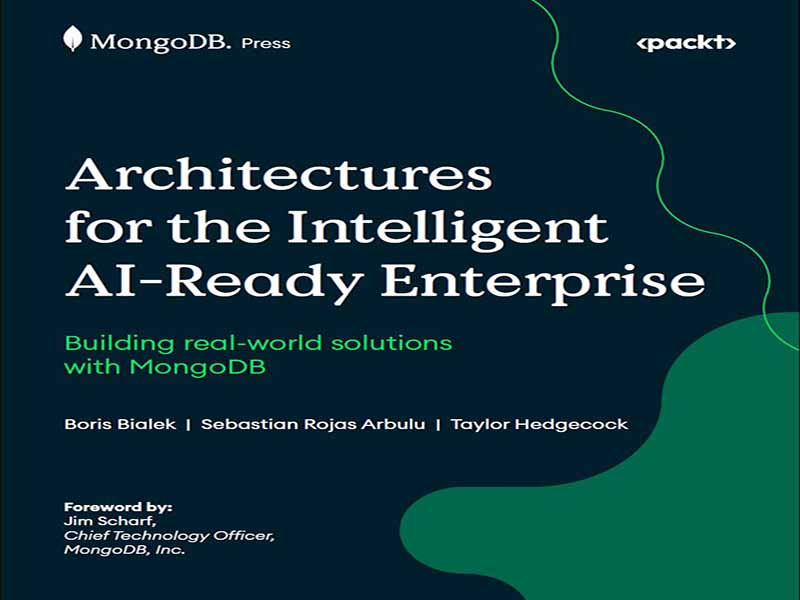- عنوان کتاب: Architectures for the Intelligent AI-Ready Enterprise -Building real-world solutions with MongoDB
- نویسنده: Boris Bialek, Sebastian Rojas Arbulu
- حوزه: سازمان هوشمند, MongoDB
- سال انتشار: 2025
- تعداد صفحه: 510
- زبان اصلی: انگلیسی
- نوع فایل: pdf
- حجم فایل: 9.11 مگابایت
این کتاب در مورد چگونگی فراتر رفتن سازمانها از پذیرش هوش مصنوعی در سطح سطحی و پیادهسازی هوش مصنوعی به عنوان یک محرک واقعی تحول در کسبوکار است. این کتاب اهمیت استراتژیک تمایز بین نوسازی و نوآوری و چگونگی ضروری بودن هر دو برای استقرار موفقیتآمیز هوش مصنوعی را توضیح میدهد. از طریق پیادهسازیهای دنیای واقعی، داستانهای موفقیت و چارچوبهای عملی، نقشه راهی برای پیمایش نقطه عطف هوش مصنوعی، همسو کردن زیرساخت دادهها با اهداف هوش مصنوعی و ساخت سیستمهای هوش مصنوعی قابل اعتماد، مقیاسپذیر و آگاه از زمینه ارائه میدهد. این کتاب در سه بخش سازماندهی شده است. بخش اول، پایه و اساس را بنا میکند و مفاهیم اصلی هوش مصنوعی، معماریهای سیستم، حاکمیت و رویکردهای نوسازی را که سازمانها را برای پذیرش در مقیاس بزرگ آماده میکنند، پوشش میدهد. بخش دوم، کاربردهای صنعتی را بررسی میکند و نشان میدهد که چگونه هوش مصنوعی عاملگرا و مولد (GenAI) میتوانند بخشهایی مانند تولید، رسانه، خردهفروشی، خدمات مالی، بیمه و مراقبتهای بهداشتی را تغییر شکل دهند. بخش آخر، با ارائه الگوهای پیادهسازی پیشرفته، مدلهای حاکمیت و فناوریهای نوظهور مانند پروتکل زمینه مدل (MCP) و هوش مصنوعی سببی، خوانندگان را به استراتژیهایی برای حفظ نوآوری و سازگاری با موج بعدی سیستمهای هوشمند مجهز میکند. این کتاب برای موارد زیر است: • تصمیمگیرندگان فناوری اطلاعات که در حال بررسی محل شرطبندیهای استراتژیک هوش مصنوعی هستند • معماران سازمانی و راهحل که در حال بازنگری دادهها و پشته برنامههای خود هستند • گوشهای فنی و سازندگان کنجکاوی که میخواهند نحوه ساختاردهی و استقرار سیستمهای هوشمند را درک کنند • استراتژیستهای تجاری و صاحبان دامنه که به دنبال تبدیل تبلیغات هوش مصنوعی به نتایج خاص دامنه هستند. برای بهرهمندی از این کتاب نیازی به تجربه عمیق هوش مصنوعی ندارید، اما باید در تفکر از نظر سیستمهای داده، لایههای برنامه و معماری کسبوکار احساس راحتی کنید. اگر قبلاً با مفاهیم هوش مصنوعی مطرح شده در اینجا تجربه دارید، میتوانید فصلهای اولیه را رد کنید و به مطالعات موردی دنیای واقعی و محتوای آیندهنگر بپردازید. آنچه این کتاب پوشش میدهد: فصل 1، نوسازی هوش مصنوعی تا نوآوری، تفاوت بین نوسازی و نوآوری واقعی و نحوه ساختاردهی تیمها، دادهها و فرآیندها را برای تبدیل آزمایشهای هوش مصنوعی به نتایج تجاری تشریح میکند. فصل 2، چه چیزی GenAI، RAG و Agentic AI را از هم جدا میکند، GenAI، RAG و سیستمهای Agentic را تعریف میکند و توضیح میدهد که چه زمانی از هر رویکرد استفاده شود. فصل ۳، سیستم اقدام، سیستم اقدام مبتنی بر سند را شرح میدهد و اینکه چرا دسترسی یکپارچه و کمتاخیر به دادهها و تعبیههای چندوجهی برای حجم کار هوش مصنوعی حیاتی است. فصل ۴، هوش مصنوعی قابل اعتماد، انطباق و مدیریت دادهها، خلاصهای از شیوههای مدیریت، حریم خصوصی، قابلیت توضیح و مدیریت ریسک مورد نیاز برای هوش مصنوعی تولیدی ارائه میدهد. فصل ۵، نوسازی با استفاده از هوش مصنوعی، الگوهای عملی برای استفاده از هوش مصنوعی برای تسریع نوسازی قدیمی در عین حفظ صحت و حاکمیت ارائه میدهد. فصل ۶، کاربردهای عملی Agentic و GenAI در تولید – بخش ۱، بر موارد استفاده زنجیره تأمین و موجودی، از جمله طبقهبندی مبتنی بر تعبیه و دستیاران تدارکات مستقل تمرکز دارد. فصل ۷، کاربردهای عملی Agentic و GenAI در تولید – بخش دوم، بر عملیات کارخانه، از جمله نگهداری پیشبینانه، بازرسی کیفیت و هماهنگی تولید چندعاملی تمرکز دارد. فصل ۸، استراتژیهای مبتنی بر هوش مصنوعی برای صنایع رسانه و مخابرات، شخصیسازی، تجربیات جستجو، عملیات هوش مصنوعی و تشخیص تقلب متناسب با بخشهای رسانه و مخابرات را پوشش میدهد. فصل ۹، «صدا و چتباتهای کاگنیگی در زمان هوش مصنوعی عاملدار»، سیستمهای صوتی و چت را برای تعاملات هدفمند و با بازده بالا با مشتری بررسی میکند. فصل ۱۰، «بهرهگیری از هوش مصنوعی برای متحول کردن صنعت خردهفروشی»، شخصیسازی، پیشبینی تقاضا، بهینهسازی موجودی و تصمیمگیری بلادرنگ در خردهفروشی را توضیح میدهد. فصل ۱۱، «خدمات مالی و موج بعدی هوش مصنوعی»، تحول بعدی هوش مصنوعی این بخش را از بینش مشتری و اتوماسیون انطباق گرفته تا مدیریت ریسک و مدلهای خدماتی بهبود یافته با هوش مصنوعی تشریح میکند. فصل ۱۲، «دادههای ثبتشده»، «مونگودیبی» و «هوش مصنوعی سفری: حفاظت معنایی دادهها در FSI»، رویکردهای حفاظت معنایی و حسابرسی را شرح میدهد که امکان استفاده منطبق از مدلهای زبان بزرگ (LLM) را در امور مالی فراهم میکند. فصل ۱۳، «پیشبرد موفقیت مشتری در بانکداری با کمکخلبانان GenAI»، نشان میدهد که چگونه کمکخلبانان بانکی میتوانند وظایف مشاوره، تحقیقات سطحی و پشتیبانی از ارتباطات منطبق با مشتری را خودکار کنند. فصل ۱۴، ارائه ارزش تجاری با هوش مصنوعی در بیمه، به تشریح انبارهای داده همگرا و الگوهای هوش مصنوعی برای بهبود بیمهگری، خسارتها و نتایج مشتری میپردازد. فصل ۱۵، خودکارسازی بیمهگری بیمه با هوش مصنوعی Fireworks و MongoDB، به جزئیات یک خط لوله بیمهگری سرتاسری با استفاده از هوش مصنوعی مبتنی بر بازیابی برای دریافت و ارائه سریعتر و دقیقتر بیمهنامه میپردازد. فصل ۱۶، تحول مبتنی بر هوش مصنوعی در مراقبتهای بهداشتی و علوم زیستی، به بررسی بار کاری پزشکان با الگوهای نمای FHIR، RAG بالینی و هماهنگی مراقبت چند عاملی برای دستیابی به نتایج بهتر بیمار میپردازد. فصل ۱۷، مدیریت اسناد سازمانی با Encore و MongoDB، demon…
This book is about how organizations can move beyond surface-level AI adoption and implement AI as a true driver of business transformation. It explains the strategic importance of distinguishing between modernization and innovation, and how both are essential for successful AI deployment. Through real-world implementations, success stories, and practical frameworks, it provides a roadmap for navigating the AI inflection point, aligning data infrastructure with AI goals, and building trustworthy, scalable, and context-aware AI systems. The book is organized into three parts. The first part lays the foundation, covering core AI concepts, system architectures, governance, and modernization approaches that prepare organizations for large-scale adoption. The second part explores industry applications, showing how agentic and generative AI (GenAI) can reshape sectors such as manufacturing, media, retail, financial services, insurance, and healthcare. The final part looks ahead, presenting advanced implementation patterns, governance models, and emerging technologies such as Model Context Protocol (MCP) and causal AI, equipping readers with strategies to sustain innovation and adapt to the next wave of intelligent systems. This book is for: • IT decision-makers exploring where to place strategic AI bets • Enterprise and solution architects rethinking their data and application stack • Technical ears and curious builders who want to understand how intelligent systems are structured and deployed • Business strategists and domain owners seeking to translate AI hype into domain-specific outcomes You don’t need deep AI experience to get value from this book, but you should feel comfortable thinking in terms of data systems, application layers, and business architecture. If you’re already experienced with AI concepts covered here, feel free to skip the early chapters and jump into the real-world case studies and future-focused content. What this book covers: Chapter 1, AI Modernization to Innovation, outlines the difference between modernization and true innovation and how to structure teams, data, and processes to turn AI experiments into business outcomes. Chapter 2, What Sets GenAI, RAG, and Agentic AI Apart, defines GenAI, RAG, and agentic systems, and explains when to use each approach. Chapter 3, The System of Action, describes the document-oriented system of action and why unified, low-latency access to multimodal data and embeddings is critical for AI workloads. Chapter 4, Trustworthy AI, Compliance, and Data Governance, summarizes governance, privacy, explainability, and risk management practices required for production AI. Chapter 5, Modernization Using AI, gives practical patterns for using AI to accelerate legacy modernization while preserving correctness and governance. Chapter 6, Practical Applications of Agentic and GenAI in Manufacturing – Part 1, focuses on supplychain and inventory use cases, including embedding-driven classification and autonomous procurement helpers. Chapter 7, Practical Applications of Agentic and GenAI in Manufacturing – Part II, focuses on factory-floor operations, including predictive maintenance, quality inspection, and multi-agent production orchestration. Chapter 8, AI-Driven Strategies for Media and Telecommunication Industries, covers personalization, search experiences, AI operations, and fraud detection tailored to media and telecom sectors. Chapter 9, Cognigy’s Voice and Chatbots in the Time of Agentic AI, examines voice and chat systems for high-throughput, goal-oriented customer interactions. Chapter 10, Harnessing AI to Transform the Retail Industry, explains personalization, demand forecasting, inventory optimization, and real-time decision-making in retail. Chapter 11, Financial Services and the Next Wave of AI, outlines the sector’s next AI transformation, from customer insight and compliance automation to AI-enhanced risk management and service models. Chapter 12, RegData, MongoDB, and Voyage AI: Semantic Data Protection in FSI, describes semantic protection and audit approaches that enable compliant use of large language models (LLMs) in finance. Chapter 13, Driving Client Success in Banking with GenAI Copilots, shows how banking copilots can automate advisor tasks, surface research, and support compliant client communications. Chapter 14, Delivering Business Value with AI in Insurance, outlines converged datastores and AI patterns to improve underwriting, claims, and customer outcomes. Chapter 15, Automating Insurance Underwriting with Fireworks AI and MongoDB, details an end-toend underwriting pipeline using retrieval-grounded AI for faster, more accurate policy intake and quoting. Chapter 16, AI-Powered Transformation of Healthcare and Life Sciences, addresses clinician overload with FHIR facade patterns, clinical RAG, and multi-agent care coordination to achieve better patient outcomes. Chapter 17, Enterprise Document Management with Encore and MongoDB, demonstrates how to turn unstructured enterprise dark data into enriched, searchable knowledge for operational and AI use. Chapter 18, Democratizing Agentic AI for Enterprise with Dataworkz and MongoDB, provides architectural guidance, governance practices, and real-world cases for deploying safe, observable, and effective agentic AI. Chapter 19, Outlook: Beyond Today’s AI, looks ahead to MCP, memory-driven agents, and causal AI as drivers of the next wave of intelligent systems.
این کتاب را میتوانید از لینک زیر بصورت رایگان دانلود کنید:
Download: Architectures for the Intelligent AI-Ready Enterprise



































نظرات کاربران